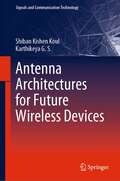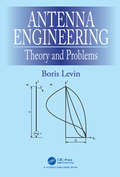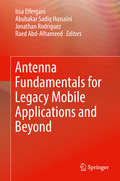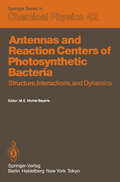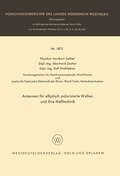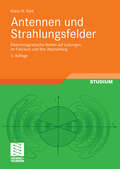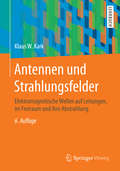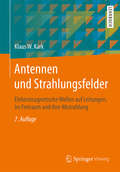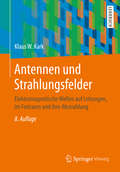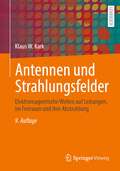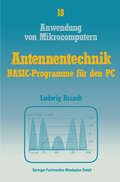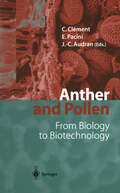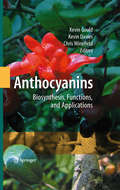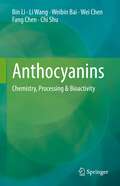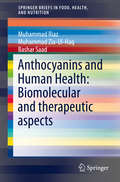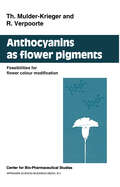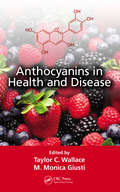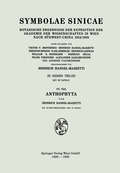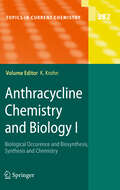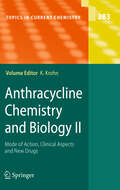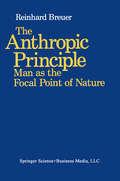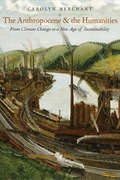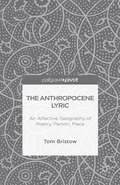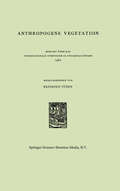- Table View
- List View
Antenna Architectures for Future Wireless Devices (Signals and Communication Technology)
by Shiban Kishen Koul Karthikeya G. S.This book presents the design requirements of antenna integration for modern commercial devices such as smartphones, dongles, and access points. Practical use-case scenarios of smartphone and the design process of the antenna system for the same are highlighted. The feasibility of scaling up sub-6GHz to mmWave antennas is also discussed in detail followed by a plethora of design examples which could be panel mounted to modern-day commercial smartphones. The unique requirement of gain switchability is introduced with feasible practical antenna designs. High efficiency antennas for 5G base stations is introduced along with a design example on planar all-metallic antenna. Beam switchability requirement for base station is illustrated with a couple of compact antenna system examples. Variety of feeding techniques for mmWave antennas is elaborated in this book. Finally, low-cost antenna designs for future wireless devices are illustrated.
Antenna Engineering: Theory and Problems
by Boris LevinThe book deals with theoretical and experimental research of antennas. The presentation is based on the electromagnetic theory. It begins with the theory of thin antennas. Thin antennas represent one of the main types of radiators, thus the theory of thin antennas is the basis of the antennas analysis. Special attention is paid to the integral equation of Leontovich-Levin for a current along a straight thin-walled metal cylinder, which is equivalent to the equation of Hallen with a precise kernel. Together with the analysis of various types of antennas, the book deals with the problems of synthesis including the creation a wide-band radiator by means of determining of the types and the magnitudes of concentrated loads, which are connected along a linear radiator and create in a given frequency band high electrical performance. Problems of antenna engineering are discussed in the second half of the book, including the results of application of a compensation method for the protection of humans against irradiation and structural features of ship antennas.
Antenna Engineering: Theory and Problems
by Boris LevinThe book deals with theoretical and experimental research of antennas. The presentation is based on the electromagnetic theory. It begins with the theory of thin antennas. Thin antennas represent one of the main types of radiators, thus the theory of thin antennas is the basis of the antennas analysis. Special attention is paid to the integral equation of Leontovich-Levin for a current along a straight thin-walled metal cylinder, which is equivalent to the equation of Hallen with a precise kernel. Together with the analysis of various types of antennas, the book deals with the problems of synthesis including the creation a wide-band radiator by means of determining of the types and the magnitudes of concentrated loads, which are connected along a linear radiator and create in a given frequency band high electrical performance. Problems of antenna engineering are discussed in the second half of the book, including the results of application of a compensation method for the protection of humans against irradiation and structural features of ship antennas.
Antenna Fundamentals for Legacy Mobile Applications and Beyond
by Issa Elfergani Abubakar Sadiq Hussaini Jonathan Rodriguez Raed Abd-AlhameedThis book highlights technology trends and challenges that trace the evolution of antenna design, starting from 3rd generation phones and moving towards the latest release of LTE-A. The authors explore how the simple monopole and whip antenna from the GSM years have evolved towards what we have today, an antenna design that is compact, multi-band in nature and caters to multiple elements on the same patch to provide high throughput connectivity. The scope of the book targets a broad range of subjects, including the microstrip antenna, PIFA antenna, and the monopole antenna to be used for different applications over three different mobile generations. Beyond that, the authors take a step into the future and look at antenna requirements for 5G communications, which already has the 5G drive in place with prominent scenarios and use-cases emerging. They examine these, and put in place the challenges that lie ahead for antenna design, particularly in mm-Wave design. The book provides a reference for practicing engineers and under/post graduate students working in this field.
Antennas and Reaction Centers of Photosynthetic Bacteria: Structure, Interactions and Dynamics. Proceedings of an International Workshop Feldafing, Bavaria, F.R.G. March 23–25, 1985 (Springer Series in Chemical Physics #42)
by Maria E. Michel-BeyerleThe workshop on "Antennas and Reaction Centers of Photosynthetic Bac teria" was held at Feldafing, Bavaria (F. R. G. )' March 23-25, 1985. This workshop focussed on primary processes with emphasis on structure, inter actions and dynamics. It assessed structural, spectroscopic and dynamic data which have accumulated recently, providing an overview of the mech anism of the acquisition, storage and useful disposal of energy in bacterial photosynthesis. This volume is a record of the invited papers presented at the workshop. The material was organized into five sections: I. Antennas: Structure and Energy Transfer II. Reaction Centers: Structure and Interactions III. Electron Transfer: Theory and Model Systems IV. Reaction Cen,ters: Structure and Dynamics V. Model Systems on Function of Antennas and Reaction Centers I would like to express my gratitude to all the participants in the work shop for their contributions, and to the authors for the timely preparation of their manuscripts. I am indebted to the members of the organizing committee, Professors Sighart F. Fischer and Hugo Scheer for their most valuable assistance and advice. The workshop would not have been so successful without the help of my secretary, Frau Petra KahlfuB, and my coworkers in its organization. I thank Frau KahlfuB particularly also for her assistance in the preparation of these proceedings. The workshop was organized under the auspices of the Technical Uni versity of Munich, the Max-Planck-Society and the University of Munich.
Antennen für elliptisch polarisierte Wellen und ihre Meßtechnik (Forschungsberichte des Landes Nordrhein-Westfalen #1873)
by Heribert SahlerDie in vier Abschnitten vorliegende Arbeit über das Gebiet der elliptischen Polarisation stellt in der deutschen Fachliteratur eine Neuheit dar. Sie stützt sich im wesentlichen auf US-amerikanische Arbeiten, die im Zusammenhang mit der Radartechnik, der Telemetrie und der aufkommenden Satellitentechnik und Weltraumfahrt durchgeführt wurden. In Hinblick auf die wachsende Bedeutung dieser modernen Technik, für welche die Anwendung elliptischer bzw. zirkularer Polarisation wichtig ist, empfehle ich den Hochschulstudenten und Ingenieuren der Nachrichtentechnik die selbständige Ein arbeitung in diese Materie. Zur Erleichterung der Einarbeitung ist die Ausführlichkeit der Abschnitte I und Il daher durchaus angebracht, ebenso die in Abschnitt IV ange geb enen umfangreichen Hinweise auf weiterführende Literatur, die den deutschen Fachleuten die Erfahrungen der US-amerikanischen Forscher nahebringen sollen. Die Inhaltsangabe ist aus der ausführlichen Gliederung zu ersehen und beschränkt sich im Abschnitt I zunächst auf die Untersuchung von eb enen homogenen, elliptisch polarisierten Wellen, wobei insbesondere auf den in den USA gebräuchlichen Zusam menhang mit der Darstellung im Smith-Diagramm hingewiesen wird. In Abschnitt Il werden die Antennen in die Betrachtungen mit einbezogen, und es wird die Energie übertragung zwischen zwei Antennen in Abhängigkeit von der Polarisation ausführlich behandelt. Die speziellen Arten der MeGtechnik zur Bestimmung der Polarisation sind im Abschnitt III besprochen. Dabei wird besonderer Wert auf die praktischen Anwendungen und die Erörterung der MeGgenauigkeit gelegt. Es wird gezeigt, daG durch die einfachere und genauere Vielfach-Komponenten-Messung sich komplizierte und relativ ungenaue Phasen messungen vermeiden lassen.
Antennen und Strahlungsfelder: Elektromagnetische Wellen auf Leitungen, im Freiraum und ihre Abstrahlung
by Klaus KarkDieses Lehrbuch und Nachschlagewerk - eines der besten Grundlagenbücher zum Thema überhaupt - gibt eine systematische Einführung in die Begriffswelt elektromagnetischer Strahlungsfelder. Die Antennentechnik wird von den feldtheoretischen Grundlagen bis zu praktischen Designvorschlägen mit einfach anwendbaren Kochrezepten und Faustformeln verständlich dargestellt. Neben den grundlegenden mathematischen Methoden wird großer Wert auf die physikalische Interpretation und Visualisierung der erhaltenen Ergebnisse mittels Computersimulationen gelegt. Diese anschauliche Art der Darstellung von Abstrahlung und Ausbreitung elektromagnetischer Wellen ermöglicht ein tiefer gehendes Verständnis. In der 3., erweiterten Auflage stellen 128 Übungsaufgaben mehrheitlich mit vollständigen Lösungen den Lernerfolg sicher. Auf Grund des didaktischen Konzepts ist das Buch gleichermaßen vorlesungsbegleitend für Studierende und als Nachschlagewerk für Praktiker und Anwender bestens geeignet.
Antennen und Strahlungsfelder: Elektromagnetische Wellen auf Leitungen, im Freiraum und ihre Abstrahlung
by Klaus W. KarkDieses Lehrbuch und Nachschlagewerk – eines der besten Grundlagenbücher zum Thema überhaupt – gibt eine systematische Einführung in die Abstrahlung und Ausbreitung elektromagnetischer Wellen. Die Antennentechnik wird von den feldtheoretischen Grundlagen bis zu praktischen Designvorschlägen mit einfach anwendbaren Kochrezepten, Faustformeln und 155 Übungsaufgaben verständlich dargestellt. Neben den grundlegenden mathematischen Methoden wird großer Wert auf die physikalische Interpretation und Visualisierung der erhaltenen Ergebnisse mittels Computersimulationen gelegt. Das Buch ist für Studierende neben der Vorlesung und auch als Nachschlagewerk für Praktiker und Anwender konzipiert.
Antennen und Strahlungsfelder: Elektromagnetische Wellen auf Leitungen, im Freiraum und ihre Abstrahlung
by Klaus W. KarkDieses bewährte Lehrbuch und Nachschlagewerk – eines der besten Grundlagenbücher zum Thema überhaupt – gibt eine systematische Einführung in die Abstrahlung und Ausbreitung elektromagnetischer Wellen. Die Technik der Antennen mit ihren Speiseleitungen wird von den feldtheoretischen Grundlagen bis zu praktischen Designvorschlägen mit einfach anwendbaren Kochrezepten, Faustformeln und 172 Übungsaufgaben verständlich dargestellt. Neben den grundlegenden mathematischen Methoden wird großer Wert auf die physikalische Interpretation und Visualisierung der erhaltenen Ergebnisse mittels Computersimulationen gelegt. Das Buch ist für Studierende neben der Vorlesung und auch als Nachschlagewerk für Praktiker und Anwender konzipiert.Die neue 7. Auflage wurde umfangreich überarbeitet und um 64 neue Seiten erweitert.
Antennen und Strahlungsfelder: Elektromagnetische Wellen auf Leitungen, im Freiraum und ihre Abstrahlung
by Klaus W. KarkDieses bewährte Lehrbuch und Nachschlagewerk – seit Jahren eines der besten Grundlagenbücher zum Thema überhaupt – gibt eine systematische Einführung in die Abstrahlung und Ausbreitung elektromagnetischer Wellen. Die Technik der Antennen mit ihren Speiseleitungen wird von den feldtheoretischen Grundlagen bis zu praktischen Designvorschlägen mit einfach anwendbaren Kochrezepten, Faustformeln und 195 Übungsaufgaben verständlich dargestellt. Neben den grundlegenden mathematischen Methoden wird großer Wert auf die physikalische Interpretation und Visualisierung der erhaltenen Ergebnisse mittels Computersimulationen gelegt. Das Buch ist für Studierende neben der Vorlesung und auch als Nachschlagewerk für Praktiker und Anwender konzipiert.Die neue 8. Auflage wurde umfangreich überarbeitet und um drei neue Kapitel mit 64 zusätzlichen Seiten erweitert. Insbesondere hat die Radartechnik mehr Raum erhalten und es wurden die Einflüsse des Rauschens sowie des realen Erdbodens auf Funkübertragungsstrecken neu aufgenommen.
Antennen und Strahlungsfelder: Elektromagnetische Wellen auf Leitungen, im Freiraum und ihre Abstrahlung
by Klaus W. KarkDieses bewährte Lehrbuch und Nachschlagewerk – seit Jahren eines der besten Grundlagenbücher zum Thema überhaupt – gibt eine systematische Einführung in die Abstrahlung und Ausbreitung elektromagnetischer Wellen. Die Technik der Antennen mit ihren Speiseleitungen wird von den feldtheoretischen Grundlagen bis zu praktischen Designvorschlägen mit einfach anwendbaren Kochrezepten, Faustformeln und 211 Übungsaufgaben verständlich dargestellt. Neben den grundlegenden mathematischen Methoden wird großer Wert auf die physikalische Interpretation und Visualisierung der erhaltenen Ergebnisse mittels Computersimulationen gelegt. Das Buch ist für Studierende neben der Vorlesung und auch als Nachschlagewerk für Praktiker und Anwender konzipiert.Die vorherige Auflage wurde umfangreich überarbeitet, womit in der neuen 9. Auflage nun drei weitere Kapitel mit 108 zusätzlichen Seiten hinzugekommen sind. Dabei wurde für die Yagi-Uda-Antenne ein völlig neuartiger Designprozess entwickelt, der einen einfachen Nachbau bei allen Frequenzen ermöglicht. Außerdem hat die Totalreflexion an dielektrischen Oberflächen mit Anwendungen bei Lichtwellenleitern und Prismen mehr Raum erhalten und bei den Gruppenantennen wird die Dolph-Tschebyscheff-Belegung wesentlich ausführlicher behandelt. Schließlich ist noch ein neuer Anhang mit farbigen Bildtafeln hinzugekommen, auf denen typische Antennenformen gezeigt werden.
Anther and Pollen: From Biology to Biotechnology
by Christophe Clement Ettore Pacini Jean-Claude AudranPollen, the plant structure most widely used by humans, is a key structure in plant reproduction giving rise to fruits and seeds. Moreover, the biotechnological use of pollen is of great importance for plant breeders since it allows to obtain varieties with better utilization and yield. In the first part, the successive steps of pollen development in the anther from floral induction to pollen germination and fertilization are thoroughly examined; the second part is devoted to pollen behaviour in vitro.
Anthocyanins: Biosynthesis, Functions, and Applications (Advances In Botanical Research Ser. #Volume 37)
by Kevin Davies Kevin Gould Chris WinefieldIn recent years there has been an unprecedented expansion of knowledge about anthocyanins pigments. Indeed, the molecular genetic control of anthocyanins biosynthesis is now one of the best understood of all secondary metabolic pathways. There have also been substantial improvements in analytical technology that have led to the discovery of novel anthocyanin compounds. Armed with this knowledge and the tools for genetic engineering, plant breeders are now introducing vibrant new colors into horticultural crops. The food industry has also benefited from the resurgence of interest in anthocyanins. A greater understanding of the chemistry of these pigments has led to improved methods for stabilizing the color of anthocyanins extracts, so that they are more useful as food colorings. Methods for the bulk production of anthocyanins from cell cultures have been optimized for this purpose. Possible benefits to human health from the ingestion of anthocyanin-rich foods have also been a major feature of the recent scientific literature. Anthocyanins are remarkably potent antioxidants, and their ingestion has been postulated to stave off the effects of oxidative stress. These pigments, especially in conjunction with other flavonoids, have been associated with reductions in the incidence and severity of many other non-infectious diseases, including diabetes, cardiovascular disease and certain cancers. An industry is developing around anthocyanins as nutritional supplements. Finally, there has been significant progress in our understanding of the benefits of anthocyanins to plants themselves. Originally considered an extravagance without a purpose, anthocyanins are now implicated in multifarious vital functions. These include the attraction of pollinators and frugivores, aposematic defense from herbivores, and protection from environmental stressors such as strong light, UVB, drought, and free radical attacks. Anthocyanins are evidently highly versatile, and enormously useful to plants. This book covers all aspects of the biosynthesis and function of anthocyanins (and related compounds such as proanthocyanidins) in plants, and their applications in agriculture, food products, and human health. Featured areas include their relevance to: * Plant stress * Flower and fruit color * Human health * Wine quality and health attributes * Food colorants and ingredients * Cell culture production systems * The pastoral sector
Anthocyanins: Chemistry, Processing & Bioactivity
by Bin Li Fang Chen Wei Chen Li Wang Weibin Bai Chi ShuThis book summarizes the current knowledge of anthocyanins, provides systematic information for future exploration of anthocyanin applications. It focuses on several aspects regarding the studying progression in the field of anthocyanins. The first section of the book provides a brief introduction to the scope and progress on anthocyanins, which is followed by the second section that describes the natural sources, structure, extraction approaches, bioavailability, and current stabilizing approach of anthocyanins. Then in the third part, the book focuses on the industrial processing of anthocyanins in foods by discussing the impact of food processing on anthocyanin structure and composition as well as classical processing techniques on anthocyanin-containing foods, including high-pressure, encapsulation, microwave, and combined application of the above techniques. In the last section of the book, the authors explore the currently most popular application of anthocyanins in improving human health, such as the effect of anthocyanin on vision, metabolism, neural system, cardiovascular system, and cancers. The book will facilitate readers’ understanding of the progress of anthocyanin studies. And it will benefit researchers and graduate students in the fields of natural products, functional food, and nutrition, etc.
Anthocyanins and Human Health: Biomolecular and therapeutic aspects (SpringerBriefs in Food, Health, and Nutrition #0)
by Muhammad Zia Ul Haq Muhammad Riaz Saad BasharThis Brief presents comprehensive coverage of anthocyanins. The text covers the scientific literature and clinical significance of this Flavonoid sub-group, with a special focus on their therapeutic aspects. In focusing on secondary metabolites in plants, this work aims to cover the resulting therapeutic potential for humans by referencing the numerous herbal-derived substances which have been evaluated and the rapidly growing data on the interactions of anthocyanins with the microbiome. Anthocyanins and Human Health: Biomolecular and therapeutic aspects covers all angles of biomolecular, in vitro and in vivo anthocyanins from their general chemical structure to their use as a coloring agent. The intake, metabolism and secretion of anthocyanins in the human body are covered in-depth, as are the biosynthetic pathways through which these compounds are synthesized in the natural system. Factors affecting stability and extraction are listed, and health related uses and biological activities are covered in great detail. Present and future trends in anthocyanins research are also presented.
Anthocyanins as Flower Pigments: Feasibilities for flower colour modification
by T. Mulder-Krieger Robert VerpoorteTo date, several possibilities exist to change the genetics of plants including classical breeding and modern molecular biological approaches such as recombinant DNA techniques and plant trans formation methods. The aim of this publication is to review the feasibilities, offered by the current technologies, to modify flower colours. Due to the great importance of anthocyanins as flower pigments, the main part of this study deals with this class of flavonoids responsible for most red-, purple- and blue colours. Being electron deficient, the flavylium nucleus of the anthocyanins is highly reactive and undergoes - dependent upon pH - readily structural transformations which are coupled with colour changes. A number of mechanisms that stabilizes the coloured - at expense of the colourless structures in plants are described, including acylation, co pigmentation and metal complex formation. Because no plant species possesses the genetic capacity for producing varieties in the full spectrum of colours, man has looked for methods to change the genetic properties of plants. In recent years, conventional flower breeding is more and more being supplemented by genetic engineering techniques. This technology offers the possibility to insert specific genes into the cell genome and to transfer genes most efficiently between different organisms. The common flower pigments, the anthocyanins, have been studied for many years and represent now the best understood group of secondary plant metabolites with respect to (bio)chemistry and genetics.
Anthocyanins in Health and Disease
by Taylor C. Wallace M. Monica GiustiAnthocyanins, polyphenolic compounds abundant in certain foods, are responsible for the orange-red to blue-violet hues evident in many fruits, vegetables, cereal grains, and flowers. Interest in these pigments has intensified due to their potential health-promoting properties as dietary antioxidants, as well as their use as natural dyes in a variet
Anthophyta
by Heinrich von Handel-MazzettiDieser Buchtitel ist Teil des Digitalisierungsprojekts Springer Book Archives mit Publikationen, die seit den Anfängen des Verlags von 1842 erschienen sind. Der Verlag stellt mit diesem Archiv Quellen für die historische wie auch die disziplingeschichtliche Forschung zur Verfügung, die jeweils im historischen Kontext betrachtet werden müssen. Dieser Titel erschien in der Zeit vor 1945 und wird daher in seiner zeittypischen politisch-ideologischen Ausrichtung vom Verlag nicht beworben.
Anthracycline Chemistry and Biology I: Biological Occurence and Biosynthesis, Synthesis and Chemistry (Topics in Current Chemistry #282)
by Karsten KrohnWith contributions by numerous experts
Anthracycline Chemistry and Biology II: Mode of Action, Clinical Aspects and New Drugs (Topics in Current Chemistry #283)
by Karsten KrohnThis series presents critical reviews of the present position and future trends in modern chemical research. It contains short and concise reports on chemistry, each written by the world renowned experts. The series is still valid and useful after five or ten years. More information as well as the electronic version of the whole content is available at: springerlink.com.
The Anthropocene and the Humanities: From Climate Change to a New Age of Sustainability (The Future Series)
by Carolyn MerchantA wide-ranging and original introduction to the Anthropocene that offers fresh, theoretical insights bridging the sciences and the humanities From noted environmental historian Carolyn Merchant, this book focuses on the original concept of the Anthropocene first proposed by Paul Crutzen and Eugene Stoermer in their foundational 2000 paper. It undertakes a broad investigation into the ways in which science, technology, and the humanities can create a new and compelling awareness of human impacts on the environment. Using history, art, literature, religion, philosophy, ethics, and justice as the focal points, Merchant traces key figures and developments in the humanities throughout the Anthropocene era and explores how these disciplines might influence sustainability in the next century. Wide-ranging and accessible, this book from an eminent scholar in environmental history and philosophy argues for replacing the Age of the Anthropocene with a new Age of Sustainability.
The Anthropocene Lyric: An Affective Geography of Poetry, Person, Place
by Tom BristowThis book takes the work of three contemporary poets John Burnside, John Kinsella and Alice Oswald to reveal how an environmental poetics of place is of significant relevance for the Anthropocene: a geological marker asking us to think radically of the human as one part of the more-than-human world.
Anthropogene Vegetation: Bericht über das Internationale Symposium in Stolzenau/Weser 1961 (Berichte über die Internationalen Symposia der Internationalen Vereinigung für Vegetationskunde #5)
by R. TüxenBericht über das Internationale Symposium in Stolzenau/Weser, 1961, der Internationalen Vereinigung für Vegetationskunde
